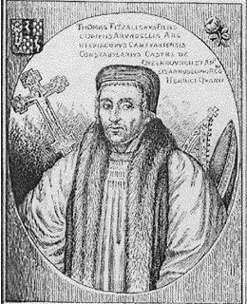| Thomas Arundel  Born: 1353 Born: 1353
Died: 19-Feb-1414
Location of death: Canterbury, England
Cause of death: unspecified
Gender: Male
Religion: Roman Catholic
Race or Ethnicity: White
Occupation: Religion Nationality: England
Executive summary: Archbishop of Canterbury, 1396-1414 Archbishop of Canterbury, the third son of Richard Fitzalan, earl of Arundel and Warenne, by his second wife, Eleanor, daughter of Henry Plantagenet, earl of Lancaster. His family was an old and influential one, and when Thomas entered the church his preferment was rapid. In 1373 he became archdeacon of Taunton, and in April 1374 was consecrated bishop of Ely. During the early years of the reign of King Richard II he was associated with the party led by Thomas, duke of Gloucester, Henry, earl of Derby, afterwards King Henry IV, and his own brother Richard, earl of Arundel, and in 1386 he was sent with Gloucester to Eltham to persuade Richard to return to parliament. This mission was successful, and Arundel was made lord chancellor in place of Michael de la Pole, duke of Suffolk, and assisted to make peace between the king and the supporters of the commission of regency. In April 1388 he was made archbishop of York, and, when Richard declared himself of age in 1389, he gave up the office of chancellor, to which, however, he returned in 1391. During his second tenure of this office he removed the courts of justice from London to York, but they were soon brought back to the metropolis.
In September 1396 he was translated from York to Canterbury, and again resigned the office of chancellor. He began his new rule by a vigorous attempt to assert his rights, warned the citizens of London not to withhold tithes, and decided appeals from the judgments of his suffragans during a thorough visitation of his province. In November 1396 he had officiated at the marriage of Richard and Isabella, daughter of Charles VI, king of France, and his fall was the sequel of the king's sudden attack upon the lords appellant in 1397. After the arrest of Gloucester. Warwick and Arundel, the archbishop was impeached by the Commons with the king's consent, although Richard, who had not yet revealed his hostility, held out hopes of safety to him. He was charged with assisting to procure the commission of regency in derogation of the royal authority, and sentence of banishment was passed, forty days being given him during which to leave the realm. Towards the end of 1397 he started for Rome, and Pope Boniface IX, at the urgent request of the king, translated him to the see of St. Andrews, a step which the pope afterwards confessed he repented bitterly. This translation virtually deprived Arundel of all authority, as St. Andrews did not acknowledge Boniface. He then became associated with Henry of Lancaster, but did not return to England before 1399, and the account which Froissart gives telling how he was sent by the Londoners to urge Henry to come and assume the crown is thought to refer to his nephew and namesake, Thomas, earl of Arundel. Landing with Henry at Ravenspur, he accompanied him to the west. He took his place at once as archbishop of Canterbury, witnessed the abdication of Richard in the Tower of London, led the new king, Henry IV, to his throne in presence of the peers, and crowned him on the 13th of October 1399.
The main work of his later years was the defense of the church, and the suppression of heresy. To put down the Lollards, he called a meeting of the clergy, pressed on the statute de haeretico comburendo, and passed sentence of degradation upon William Sawtrey. He resisted the attempt of the parliament of 1404 to disendow the church, but failed to induce Henry to pardon Archbishop Scrope in 1405. In 1407 he became chancellor for the fourth time, and in 1408 summoned a council at Oxford, which drew up constitutions against the Lollards. These he published in January 1409, and among them was one forbidding the translation of the Bible into English without the consent of the bishop of the diocese, or of a provincial synod. In 1411 he went on an embassy abroad, and in 1412 became chancellor again, his return to power being accompanied by a change in the foreign policy of Henry IV. In 1397 he had sought to vindicate his right of visitation over the university of Oxford, but the dispute remained unsettled until 1411 when a bull was issued by Pope Gregory XII recalling one issued by Pope Boniface IX, which had exempted the university from the archbishop's authority. In 1413 he took a leading part in the proceedings against Sir John Oldcastle, Lord Cobham, and in the following year he died on the 19th of February, and was buried at Canterbury. A legend of a later age tells how, just before his death, he was struck dumb for preventing the preaching of the word of God.
Father: Richard Fitzalan, Earl of Arundel
Mother: Eleanor Plantagenet
Brother: Richard, Earl of Arundel
Archbishop of Canterbury (1396-1414)
Exiled
Requires Flash 7+ and Javascript.
Do you know something we don't?
Submit a correction or make a comment about this profile
Copyright ©2019 Soylent Communications
|